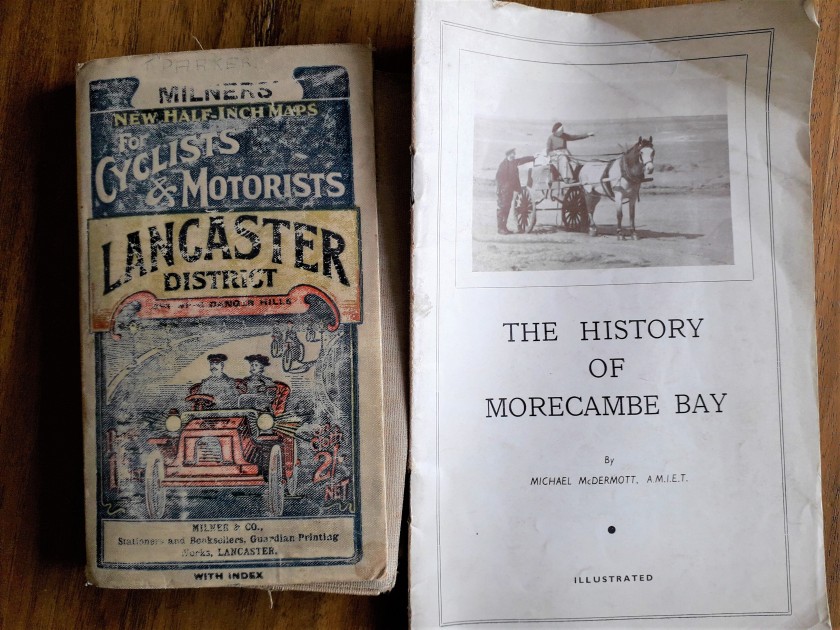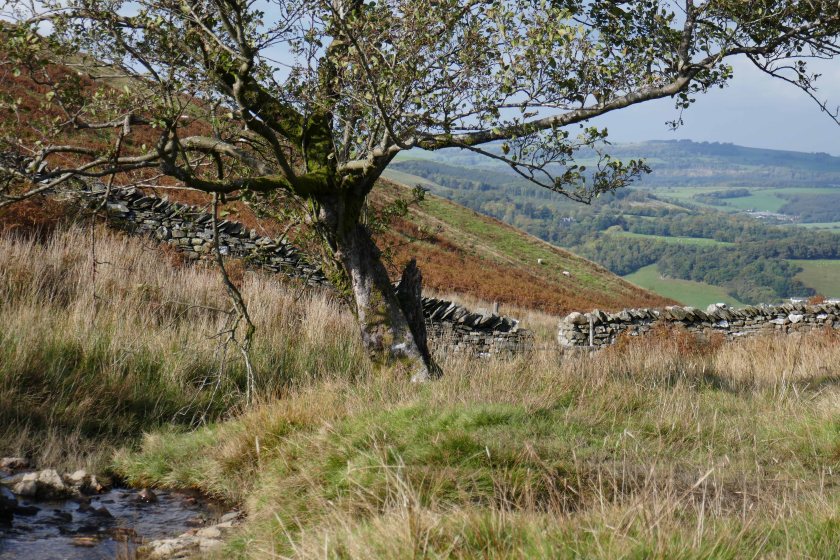
When we moved to Morecambe we received a whole pile of cards wishing us happiness in our new home and a few lovely gifts. One of the most memorable gifts was from an old friend whose grandma had lived in Bolton-le-Sands on Morecambe Bay. She generously gave us two items that had once belonged to her grandmother.
The old half-inch map for cyclists and motorists for the Lancaster District is a beautiful cloth map that has been unfolded and folded many times. I enjoy looking at old maps and this one gives an interesting insight into how Morecambe grew in the latter half of the 20th century. Our bungalow was built in the 1960s and the map shows the fields that were here before and Morecambe is shown as a fishing village and not the seaside resort it is now. Inside the cardboard cover to the map are two adverts that give a glimpse into another world. One is to Tranter’s First Class Temperance Hotel in Bridgewater Square and the other is for Dr J Collis Browne’s Chlorodyne, a remedy for coughs, colds, consumption, bronchitis and asthma which will also cut short attacks of epilepsy and hysteria and makes claims as being useful for a wide range of illnesses from gout and cancer to toothache!
My friend’s other gift was , ‘The History of Morecambe Bay’ by Michael McDermott, an illustrated pamphlet from 1948. In his forward, Michael McDermott tells us that, ‘For years it has been my custom to cycle along the coast, and thus come across many of the antiquities of the area.’ I am sure Michael McDermott also owned a copy of the old cloth map.
Michael McDermott begins by considering the origin of the name Morecambe [pronounced more – cam, the b and e are silent] and suggests the name may mean the bending shore or the beautiful haven or that it may derive from Mwr Cwm, meaning hollow in the hills. Today, according to The Morecambe Bay Partnership, the name is from, Morikambe eischusis [tidal flats in Greek]. This name was recorded on a map between the Solway and Ribble estuaries by the Greek astronomer Ptolemy in 150 AD.
Michael McDermott’s journey around Morecambe Bay begins in Lancaster with the Romans and then follows the River Lune to the picturesque Sunderland Point and the gem that is Overton Church. He then takes his reader by bicycle on to Heysham, which he describes as a ‘wooded headland’ with the stone coffins on the headland and he gives some details about the area’s links with St Patrick.
Moving north, Michael McDermott frustratingly doesn’t have much to say about Morecambe itself. ‘Adjacent to Heysham we have the holiday resort of Morecambe, which has developed in the last hundred years from a small fishing village called Poulton-le-Sands. Morecambe has the usual theatres, fair-grounds and swimming-bath of a holiday resort, and beyond that is of little interest to us.’ So much has changed in Morecambe since 1948, with the fair and lido now gone and I would have been very interested to read about what the town was like 70 years ago.
This clearly isn’t the booklet to get a clear picture of Morecambe back in the 1940s but reading it aloud to each other we did learn about Torrisholme long barrow. Michael McDermott writes, ‘The skulls found in barrows like this are peculiarly elongated in form, and the name given to the particular race who erected the long barrows is “the long-headed men.” Some barrows are round – they were built by the “round-headed men.”‘ Now referred to as a Bronze Age Round Barrow, some suggest Torrisholme Barrow was the old law hill of the area before Lancaster Castle was built but no one refers to the people that built it as having particularly elongated heads!
Michael McDermott does give us a glimpse of the fishing industry that existed around Morecambe Bay. He tells us that you would once have seen fishermen cleaning mussels on the promenade at Morecambe and at Bolton-le-Sands he meets Mr and Mrs Wilson who search for cockles in the bay in all weathers. He describes the cockle beds and the ‘cram,’ a curved fork used to scoop up the cockles and a board with handles that was called a ‘jumbo’ and was used to bring the cockles to the surface. He romanticises the hard work of these ‘fisher-folk,’ telling us, ‘Living close to nature as they do, the minds of the fisherfolk are totally free from the inhibitions that are the curse of an over-industrialised society, and their spontaneous generosity, humour, and interest in simple things make their friendship a pleasure for all who are fortunate to come into contact with them.’
Much of the pamphlet gives readers the details about the route across the sands of Morecambe Bay. Before the railway and good roads this was a frequently used, if perilous, way from Ulverston to Furness and Kents Bank to Arnside and Hest Bank. There is still a Queen’s Guide to the Kent Sands living in the house on Cart Lane at Kents Bank and regular cross bay walks for charity occur in the summer and are a marvellous and safe day out. Michael McDermott tells us that, ‘The post of Guide to the Sands is many centuries old, and was created by the Crown in 1337, after several people had lost their lives while making the crossing.’
The other method of traversing Morecambe Bay is also referred to in the pamphlet. It seems that swimming across Morecambe Bay used to be a summer event that attracted many competitors. The course from Grange to Morecambe was first completed in 1907 by “Professor” Stearne in three hours 45 minutes 41 seconds. Due to changes in the waters of Morecambe Bay the swim was stopped in 1991.
Although out-of-date, this charming history booklet has told us about a number of places we didn’t know. On the Cumbrian side of Morecambe Bay are the earth works of a motte and bailey castle on Adlingham’s Moat Hill. In the 1940s this was thought to be another burial mound and Michael McDermott quite alarmingly writes, ‘In view of the many signs of early man which have been unearthed in this neighbourhood, there is no doubt that in the dim past this area was the most important part of the bay, and countless young girls must have been butchered in the exotic religious rights which the old heathens carried out at their stone circles and caves.’
While ideas about the activities of ancient people have changed considerably, Morecambe Bay remains an English gem that is well worth exploring.




